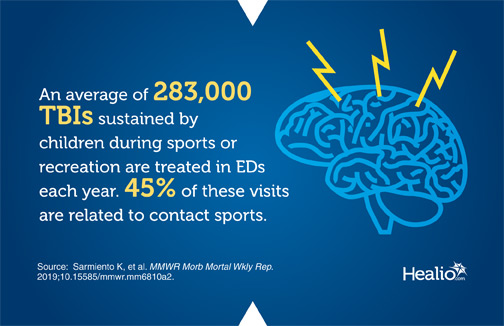More than 280,000 kids treated for TBIs in EDs every year
Pediatric sports- and recreation-related traumatic brain injuries, or SRR-TBIs, cause more than 280,000 visits to EDs throughout the United States, according to researchers from the CDC. Nearly half of these SRR-TBIs are caused by contact sports.
According to Kelly Sarmiento, MPH, a public health advisor in the CDC’s Division of Unintentional Injury Prevention’s traumatic brain injury team, and colleagues, previous research has suggested that children account for 70% of ED visits for SRR-TBIs.
The researchers examined all reported SRR-TBI cases presenting to American EDs between 2010 and 2016.
According to the researchers, an average of 283,000 SRR-TBIs among children aged younger than 18 years were treated in an emergency setting each year during the study period. Sarmiento and colleagues observed a “leveling off” in recent years. They theorized that this change beginning in 2012 may have occurred due to successful prevention efforts such as safety-minded rule changes in contact sports, declining participation in these sports or changes in care-seeking behaviors.

Male children had the highest rate of concussion, along with children aged 10 to 14 years and 15 to 17 years. Contact sports were the source of SRR-TBI for approximately 45% of all ED visits. When activity type was examined, football, bicycling, basketball, playground activities and soccer contributed to the highest number of ED visits for SRR-TBIs.
“Limiting player-to-player contact and rule changes that reduce risk for collisions are critical to preventing TBI in contact and limited-contact sports,” Sarmiento and colleagues wrote. “Development and testing of evidence-based interventions tailored for individual noncontact sports and recreation activities are warranted to ensure that children can stay healthy and active.” – by Katherine Bortz
Disclosures: The authors report no relevant financial disclosures.

